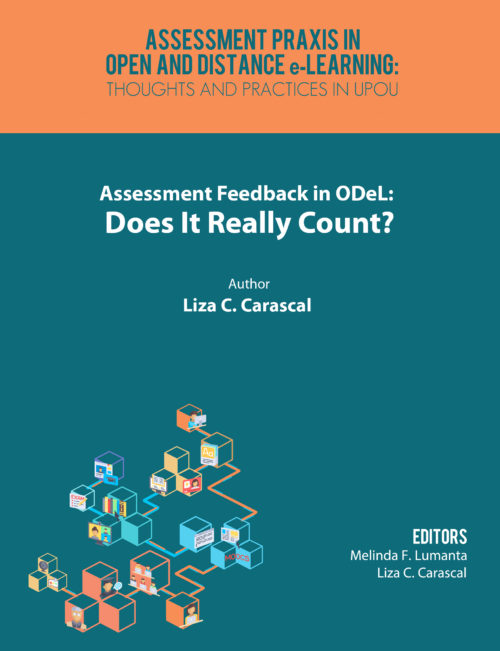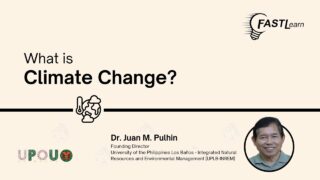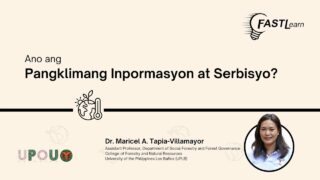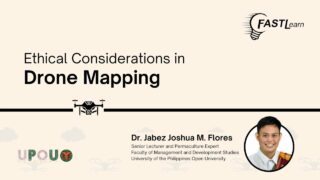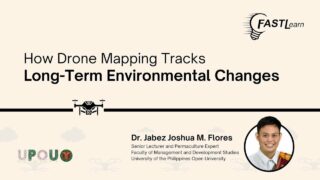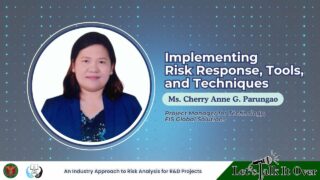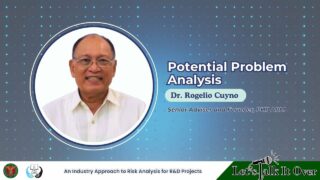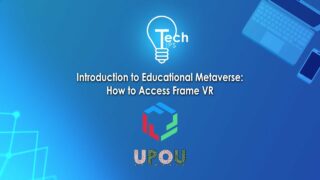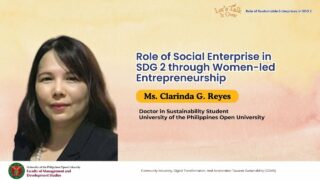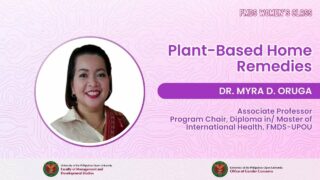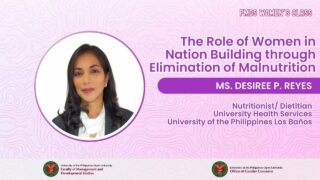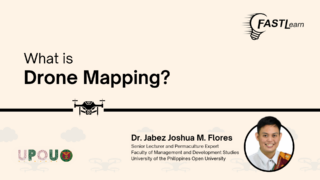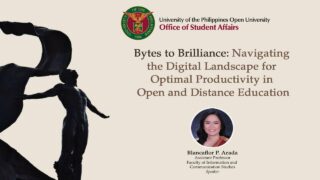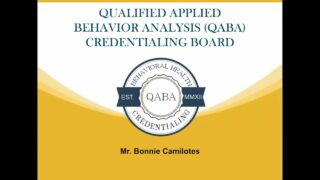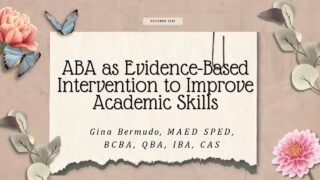Two issues about assessment have always been a concern of anyone who are involved in student assessment: students not receiving the results on time, and the seemingly insensitive feedback the students receive for their own work, thus making feedback no longer useful and effective.
Recognizing the issues, educators have now started giving attention on how assessment feedback is given and received as formative assessment rather than relying only on summative assessments. Making meaning of feedback and transforming it into insights that can support good decisions and actions is a challenging work. We often get caught up with limited perspectives and emotional reactions. We get triggered by some particular phrase that immediately hooks our attention and in the process, we miss something really important and that matters. Making feedback matter requires looking and considering multiple perspectives, seeing it in various contexts and different frames. Consequently, while there are advocates, there are also criticisms that surround assessment feedback. It could be worth presenting some relevant analyses of some research evidence on the subject as well as some result of interviews and focus group discussions with educators and students to rightfully determine if indeed assessment feedback really matters.
There have been extensive studies regarding teaching and learning but only a negligible number has been investigated on the impact of feedback on student achievement, particularly in open and distance e-Learning (ODeL). This chapter attempts to contribute to the discussion in understanding the purpose, impact, and framework of feedback in the ODeL context. Some thoughts gathered from related studies and the teaching practice are reflected in this article.
Assessment feedback is an important element of any learning process whether in ODeL or F2F setting. It comes in different forms, providing students the opportunity to reflect on their own learning. In Hattie and Timperley’s article (2007), feedback is defined as “information provided by an agent (i.e., teacher, peer, book, parent, self, experience) about aspects of one’s performance or understanding.” From the information, a student can reflect on herself or himself after an experience to assess how she or he has performed. The ways of providing assessment feedback vary, particularly in an ODeL setting where communication is usually done using current technologies and communication systems. Those in the academics have recognized the need for information about their students achieving the objectives of the course and expected learning outcomes. Oftentimes, instruction and feedback are intertwined, where the instructor provides feedback to a student about what she or he has done well or not, and then gives instruction on how to improve work on given task.
Winne and Butler (1994) noted that “feedback is information with which the student can confirm, add to, overwrite, tune, or restructure information in memory, whether that information is domain knowledge, meta-cognitive knowledge, belief about self and tasks, or cognitive tactics or strategies”.
Relatedly, Kulhavy (1977), pointed out that feedback does not always have to be taken positively by the receiver. Some feedback are acknowledged by the receiver as they are given resulting to further action to improve while some feedback are simply ignored.
Still, more studies have supported that assessment feedback that is given on time, focused on the objective, and very specific enables students to undertake possible modification and improvement of their work, thus gaining better insights. Feedback also provides opportunities for students to assess their own skills and capabilities. Feedback can be provided individually or by groups not only by the instructors or tutors but also through self- and peer assessments.
Meanwhile, Tait (2000) noted that there are a variety of ways and strategies to address student needs in support to the materials provided in the course while helping students gain full understanding and develop the expected skills. Student support services such as regular tutorials, communication media using current technology, counselling, student groups, administrative support, such as an institutional feedback system are critical and necessary in the context of ODeL. Continuing discussions on the subject would provide a venue to further review other ways to provide quality student support services. However, we should not be surprised if there are ODeL institutions that are insensitive in addressing student needs. These practices may include assessment results and feedback which are not returned and given on time, inadequate enough for students to know how well they are doing on specific task, and not specifically focused on the objectives. These feedback are certainly not effective since they fail to address what the students really need. It is of prime importance that instructors take into consideration that students may not have the opportunities to engage instructors for further explanation on the feedback they received (Bedford, 2006).
In practice, assessment feedback should be given within the learning context in order to connect the gap between what the student learns (and does) and what is aimed to be learned (or to do). Further, Hattie and Timperley (2007) reiterated that feedback is not just given, but it can also be sought and even detected without the intention of seeking it. In Hattie’s (1999) extensive studies on learning, it has been clearly shown that giving feedback is one powerful force on student achievement, along with “direct instruction, reciprocal teaching, and students’ prior cognitive ability”. A study on the impact of feedback in an ODeL setting showed considerable variability where some type of feedback are more powerful than others (Deci, et.al., 1999). It also revealed that the greatest impact are on those feedback given to small chunks of work with comments on how to do it better to improve performance. Meanwhile, meaningful online feedback which provides reinforcement to students usually requires technology-driven communication media. Evidence- based practice in ODeL shows that constructive online feedback which students find most effective are those which relate to the learning goals.
On the contrary, structured instruction, use of rewards, negative measures such as penalties, and some other extrinsic rewards do not reveal any positive effect in enhancing student achievement. Referring to Deci and colleagues (1999), extrinsic feedback was found to “undermine learners’ taking responsibility for motivating or regulating themselves”. Bedford (2007) pointed out that students are demotivated to move forward with the absence of carefully-delivered feedback comments. Expectedly, any learning activity which includes feedback should be meaningful so that students will be encouraged to connect with the lesson and the course goals. Chetwynd & Dobbyn (2011) further support the earlier claim that in the ODeL context, quality student assessment feedback has a vital and crucial role on student retention as well as in guiding students to develop skills on self-regulation.
When providing information on correct rather than incorrect answers, feedback is also effective. However, it has the most impact when students are clear about the specific goals and are given challenging tasks that are low in complexity.
Assessment feedback is now being referred to as any academic process or activity (both in ODeL and conventional modes) that contributes to the improvement of student learning by allowing students to reflect on their current level of attainment. It is expected to be responsive to the department or unit’s expectations of their programs and disciplines. However, specific details of giving and receiving feedback may then vary across units in the University and at different stages.
Effective assessment feedback in ODeL demands a good working teacher-student relationship, one that is based on mutual respect and trust. Since instructors need to provide students with quality feedback to enable them to reflect on the work they have done, providing assessment feedback that are non-evaluative and using encouraging words would help motivate students to think about the areas that need improvement and how they can still improve their performance. Consequently, quality assessment feedback provides students a clearer view of the expected learning outcomes.
In the same way, feedback from students provides the instructors or any academic staff the opportunity to reflect on the course content and their teaching pedagogy including the way they deliver the course. Thus, feedback is an effective and meaningful part of the teaching-learning process that provides multi-level benefits.
While instructor feedback benefits students with important information which helps them achieve the learning goals, students can also work together and mentor each other. The use of student to student assessment feedback in an online course is students get to assume the usual responsibility of the instructor where they assess and critique work of fellow students. However, a crucial point in this kind of feedback is that it should be focused on the learning goal. It is imperative that students are provided with rubrics to guide them about quality and timely assessment feedback. Instructors should encourage students to be fair and to give positive feedback so that they will be encouraged to do better. Asking students for their timely and quality student to student feedback also gives them the opportunity for self-reflection as they are able to evaluate their own standards with that of the other students in their class.
Where feedback is aimed to allow students to improve learning, students expect it not to be given only at the end of the semester or module with written comments on where they have gone wrong. Feedback has to be a two-way communication which encourages students to improve performance on their submitted work during the term – whether formal, informal, graded, or non-graded. In addition, students also need the opportunity to provide instructors some valuable information about their learning and level of attainment in order to achieve the intended learning goals. Thus, feedback is an on-going process of dialogue and reflection.
According to Kintsch (2009), instructors in ODeL need to guide their students to check on their current level of attainment on a given task, providing them hints to fully understand what went wrong and what to do to improve their work. Instructors must provide students with additional resources, allowing students to try other ways or strategies – even complex ones. With greater focus on the content, assessment feedback helps improve student work including challenging problems even without tutor or instructor support.
Formative feedback serves as “feedback for learning” it is given to the students during the course of a module for them to use it to enhance and improve their performance. This kind of feedback could also “feed forward” to the subsequent modules or courses. Shorter feedback provided to students to assess small tasks proves to be helpful in maintaining continuous dialogue between students and instructors and tutors, because it enables students to become more reflective in the learning process.
On the other hand, “feedback on learning” or summative feedback is usually a set of comments given by the instructors or tutors for the work done by students at the end of the course or module.
Most ODeL institutions use end-of-term evaluation in order to determine student satisfaction, level of teaching, and learning (Cowan, 2002). This kind of feedback from students is likewise valuable as the instructors’ feedback that students receive. As instructors reflect on their teaching, this kind of feedback informs the instructors on how students feel about how they give feedback. This process is useful in enhancing the teaching and learning experience of both students and instructors. Therefore, it becomes very crucial in ODeL to establish an effective communication system between students and teachers through a two-way system of providing feedback. This feedback process is an integral component of the teaching process, and it seems to be a common practice in ODeL. This may be because many ODeL students are not used to the online environment and organization of distance learning where there is limited social contact between learners.
With all the instructors’ and tutors’ responsibilities giving feedback on written work and other submitted requirements seems like an endless burden. However, according to Hattie (1999), “students look forward to feedback just for them, just in time, and just helping them move forward.” This encourages the tutors or instructors not to worry on how students would receive feedback. So, how can they provide feedback that students would welcome, reflect on, and eventually utilize?
Thinking about feedback from a wider spectrum of the course design and formative assessment structure would certainly ensure that it is useful and sustainable for the academics. Feeding forward focuses on this aspect which encourages students to think how they might use their learning from the summative assessment in their next course or module. Also, it has now become imperative for instructors to take advantage of feedback (which includes students’ answers and solutions to the given tasks) as much as students do. Student assessment becomes of great value when both students and teachers learn from the experience. Recently, it has been observed that minimal feedback on assessment is given as it is used only as external evaluation instrument rather than a feedback device. Combined with effective instruction and assessment design, feedback can be a powerful element in enhancing learning in ODeL.
Hattie and Timperley (2007) presented a framework in which feedback can be considered to minimize the gap between current level of attainment and expected learning outcomes. In this framework, meaningful and quality feedback needs to address the three major concerns of ODeL students: Towards what direction are we going? (What are the objectives?), How do we get there? (Are actions being undertaken to meet the objectives?), and What steps to be undertaken to make better progress?. These questions can also be translated to feed up, feedback, and feed forward. With this model, the teacher and the students work to minimize the discrepancy between current understanding and the learning goal. The student should show increased effort, with the teacher using better strategies, or the goal. Here, the teacher can provide appropriate challenging task on an identified and carefully selected platform with less complexity and assist students through effective learning strategies. The instructor can give feedback on the task level what, on the process level (how) addressing self-regulation (maybe a checklist for the student), and self-level (not necessarily related to task) of the student. Feedback on processes and self-regulation are usually most effective while feedback on task is effective when it contributes to improve process or self-regulation. However, focusing much on task feedback may encourage students to work only on the goal but not on the strategies to reach the intended outcome. It would be helpful to provide directions for information (where to find the right knowledge) and strategies (feedback on process). Feedback using numerical or letter grades are somehow ineffective than the written or verbal feedback comments on what the student can and still needs to do. Feedback to help on students’ self-regulation becomes powerful when combined with feedback on task. The students must also be willing to look at their learning skills to become effective learners. For ineffective learners, it would be useful to elaborate instructions on poorly understood concepts or performed task (task-oriented).
Effective feedback may vary according to student preferences. Some ODeL students welcome feedback that are indirectly and implicitly delivered, and is directed to the group or the whole class. Others are comfortable with feedback directed to individual students and is given in a more direct manner especially when feedback comment relates to effort shown by the student. The timeliness of giving feedback and the openness of students in receiving feedback are also important elements which impact feedback. A virtual classroom climate that encourages peer and self-assessment and allows learning from mistakes would prove to be effective for feedback to work. Assessments should not only provide snapshots of learning but should aim at providing valuable information that can be useful to both teachers and students to address the three questions (feed up, feedback, and feed forward).
As previously noted, communication is a two-way process that leads to appropriate action. In the context of developing competence in both ODel and F2F settings, it would not be too much to describe feedback as “the fuel that drives improved performance”. However, to drive improved performance, there are a number of basic principles to keep in mind. From my years in the practice of student assessment and the result of a focused group discussion with colleagues, it has been gleaned that feedback is an integral element of the student assessment process. The following principles on giving feedback could serve as a guide in ensuring that assessment feedback in ODeL really counts:
- The student’s engagement on and with assessment feedback should be highly promoted. Feedback should be an indispensable part of the two-way communication in teaching and learning and ‘continuing dialogue’ among teachers, students, and the assessment material. It can be claimed that student – student and student –teacher collaboration impact learning. This means that learning activities must include meaningful feedback to students, assessing work against the given criteria among students themselves, provide constructive feedback comments to each other’s work, provide clarifications on student’s inquiries after receiving feedback, work again on the task and eventually succeed.
- Assessment is for learning. Feedback is for the receiver, and not for the giver – careful consideration to the recipient on how your comments will be received. It should be targeted to enhance and improve learning. This is better than when feedback is heavily judgmental. Constructive feedback, should recognize and articulate the strengths of the students and encourage them to improve on areas where they are weak. Positive feedback would definitely increase their self-esteem which is what they need to start moving forward.
- Feedback must be clearly and timely communicated. When assessment result is issued months after assessment, feedback becomes irrelevant since it is no longer addressing the students’ current needs. Some universities, include in their academic policies students’ submitted work two to three weeks after submission to enable students to get greater benefits from the teacher’s feedback.
- Feedback can be instantaneous especially in the ODeL setting. The use of computer-marked assessment format can provide immediate feedback. Certain types of online worksheets such as the multiple choice type allow students to do the exercises at their own time and pace and receive immediate feedback (prepared by the teacher). Feedback much more effective when given instantaneously since students can quickly compare and analyze their thoughts against the given answer key.
- Assessment feedback can be given before work is assessed. Some ODeL teachers practice this method of giving feedback. For example, as soon as the students submit their work, the teacher issues handouts of model answers or post them in their course site with some discussions on where students could have problems. Students can read the information while they can still remember their own solutions to the questions and can instantly benefit from feedback. In assessing a student’s individual work, specific comments can be given but would no longer address the general points that were already given earlier.
- Feedback can be participative. Assessment feedback can be given to students in groups using the course management system. This would help students to realize that mistakes are inevitable and they can use the opportunity to learn from the successes and failures of each other. It is an ideal practice which have been proven helpful to give students enough time to ask questions about the feedback they received.
- Feedback quality should be maintained. Convenient as it is to just put checks or cross marks, these marks do not really provide real feedback. Students are usually discouraged in finding cross marks on their work. Even brief written comments such as “not quite, why don’t you try using this method…” would be better to alert students to things that can be improved. Feedback is effective when it is given as comments about and which demonstrates students’ specific behaviors on a given task. Giving examples where possible is an appropriate feedback. Instructors should also carefully review the content of the feedback, and how it is being given as well as the alignment of verbal and non-verbal messages. A meaningful and effective feedback must support the expected student learning outcomes and professional advancement.
- Determine which audio- or video tapes or other social media platforms can be used as tools for giving feedback. In some courses or in large classes in ODeL, it is somehow difficult to give long explanatory comments on a student’s work. For example, in my mathematics class, it is convenient to talk about the solution to a certain problem, referring to the codes written on the student papers. This kind of delivering feedback provides the benefit of the dynamics of the teacher’s own voice to emphasize important points. An added advantage is the fact that replay is allowed until students have fully understood the feedback. For the teachers, the same material may be just as relevant to use in the future.
“I appreciate the teacher’s feedback on my submitted work. It made me understand the ways
I could have done the task.” – Undergraduate ODeL student
“When I read the feedback, I gained a bit of confidence about what I can do,
and I showed progress in my class performance.” – Graduate student, PhD Program
According to students, feedback is most useful when they are given the time to reflect on it and think on how they can improve from reflecting on the feedback comments. Students gain confidence to do independent and reflective learning. In ODeL practice, the academic staff, particularly the tutors, are an important support to students in reflecting holistically on all the feedback they received across the course – where they are doing well and what exactly needs to be improved. In conclusion, assessment feedback on ODeL provides students a valuable resource that can engage them to take proactive ways to enhance and move forward on their own academic development. As an ODeL practice, student assessment feedback is an integral part of the instructional process. Moreover, assessment feedback as an effective teaching tool can help every academic practitioner to shift perspective from a simple correction and marking of student’s work to promoting collaboration among teachers and students, thus, helping students to move forward in their own learning. Making assessment feedback count in ODeL will certainly create a culture of feedback, feed students’ interests, and develop their passion.
Electronic Journal of eLearning, 8 (1), 1-12. Retrieved from www.ejel.org
Bedford, A. 2007. Providing feedback to students. CES Analysis Project. Available at: mhtml:file://C:\Documents and Settings\TemporaryInternet F
Chetwynd, F. & Dobbyn, C. (2011). Assessment, feedback and marking
guides in distance education. Open Learning, 26 (1), 67-78, DOI:10.1080/02680513.2011.538565.
Cowan, J. (2002). Eliciting student feedback from structured group sessions. Oxford: Oxford Brookes University
Deci, E.L., Koesner. R., & Ryan, M.R. (1999). A meta-analytic review of experiments examining the effects of extrinsic rewards on intrinsic motivation. Psychological Bulletin, 125, 627-668.
http://dx.doi.org/10.1037/0033-2909.125.6.627.
Hattie, J.A. (1999). Influences of student learning. Inaugural professorial address, University of Auckland New Zealand (Retrieved from http://www.arts.auckland.ax.nz/staff/index.cfm?P=8650
Hattie, J. A. & Timperely, H. (2007). The power of feedback. Review of Educational Research, 77 (1), 81-112
Kintsch, W. (2009). Learning and constructivism. In Segmund, E. & Dully, R.M. (Eds.), Constructivist Instruction: Success or Failure? New York:Routledge
Kulhavy, R.W. (1977). Feedback in written instruction: The place. Review of Educational Research, 47 (1), 211-232
Tait, A. (2000). Planning student support for open and distance learning. Open Learning, 15 (3).
Ukpo, EO. (2006). Support for distance learners in a Nigerian distance education program. Open Learning, 21 (3).
Winne, P.H. & Butler, D.L. (1994). Student cognition in learning from teaching. International encyclopedia of education (2nd ed). Oxford, UK: Pergammon
Woolfolk. A. (2007). Educational Psychology (10th ed). New York: Pearson.
Carascal, L. C. (2018). Assessment Feedback in ODeL: Does It Really Count?. In M. F. Lumanta, & L. C. Carascal (Eds.), Assessment Praxis in Open and Distance e-Learning: Thoughts and Practices in UPOU (pp. 127-138). Los Baños, Laguna, Philippines: UP Open University
